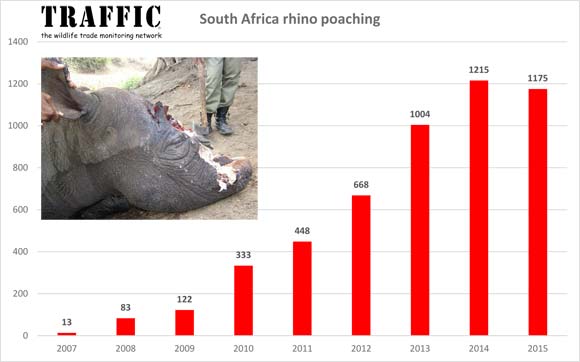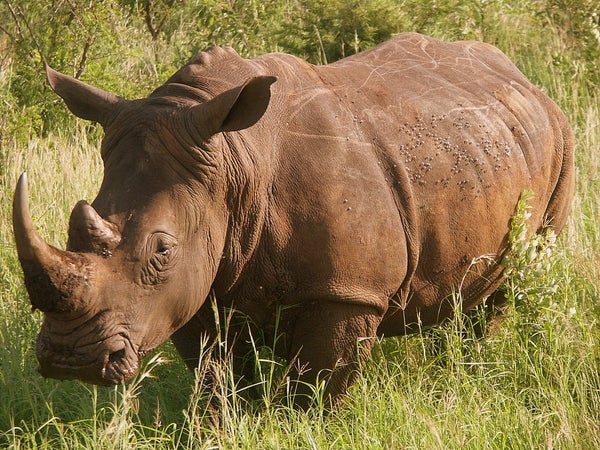This article was published in Scientific American’s former blog network and reflects the views of the author, not necessarily those of Scientific American
Poachers killed at least 1,305 rhinos in Africa in 2015, the highest number in decades, according to reports released this week.
South Africa, the country that holds the vast majority of the world’s rhinos, lost at least 1,175 rhinos last year, according to official numbers released by Minister of Environmental Affairs Edna Molewa on Jan. 21. That’s down slightly from the record high in 2014, when 1,215 rhinos were killed.

On supporting science journalism
If you're enjoying this article, consider supporting our award-winning journalism by subscribing. By purchasing a subscription you are helping to ensure the future of impactful stories about the discoveries and ideas shaping our world today.
However, poaching levels went up in two other countries. Namibia lost 80 rhinos (up from 24) while “at least 50” were killed in Zimbabwe (up from just 12), according to numbers compiled by TRAFFIC, the wildlife trade monitoring network.
Kenya has not yet reported its rhino poaching statistics for 2015, although the number is expected to be lower than last year. The country lost 24 rhinos in 2014, according to the website Poaching Facts.
None of these counts break down the losses by species—Africa is home to both the white rhinoceros (Ceratotherium simum) and the black rhinoceros (Diceros bicornis)—nor do they include the various species of Asian rhinos. India, home to the biggest population of Indian or greater one-horned rhinoceros (Rhinoceros unicornis), lost as many as a few dozen animals to poachers in 2015.
It’s also possible that the official numbers don’t accurately count all of the dead rhinos. Experts have often criticized South Africa’s poaching statistics, saying they don’t count every dead rhino. The organization Outraged South African Citizens Against Rhino Poaching argues that poaching numbers should also include any young rhinos that die due to starvation or predation after their mothers are poached.
What is clear, however, is that enforcement is improving. South Africa arrested 317 poachers in 2015, up from 258 in 2014. Many other poachers were also killed by park rangers.
Of course, poachers also murdered quite a few people in return.
The next year is likely to present several critical opportunities to curtain rhino poaching. Last week’s meeting of the Convention on International Trade in Endangered Species of Wild Fauna and Flora (CITES) resulted in several key rhino conservation measures, with several nations agreeing to improve their regulations and collaborate on criminal investigations. Meanwhile Vietnam, one of the major consumers of rhino horn, also received strict instructions to improve its enforcement and reduce consumer demand for the illegal products.
On the other hand, this week the South African high court paved the way to restart the legal trade in rhino horns within the country, a move conservationists say could inspire further poaching and illegal international trade. Obviously, that’s a development that everyone will be watching as the year progresses and as rhino poaching numbers for 2016 start to climb.
Previously in Extinction Countdown:
